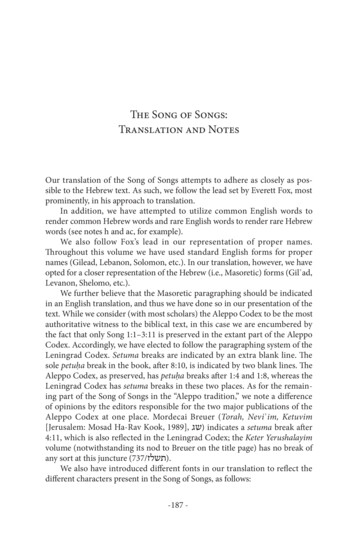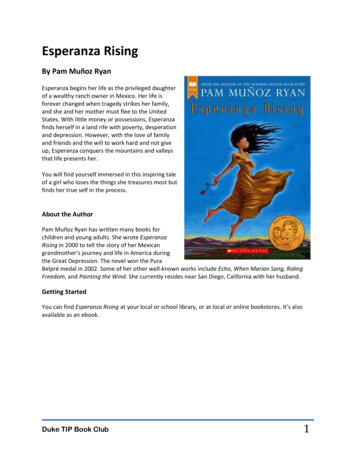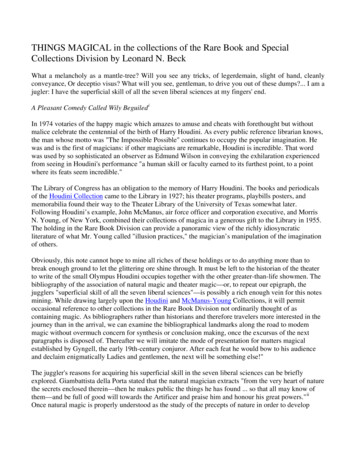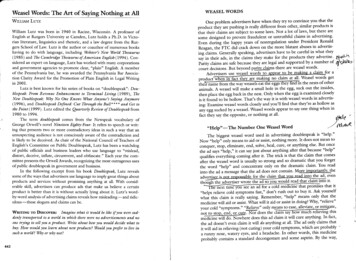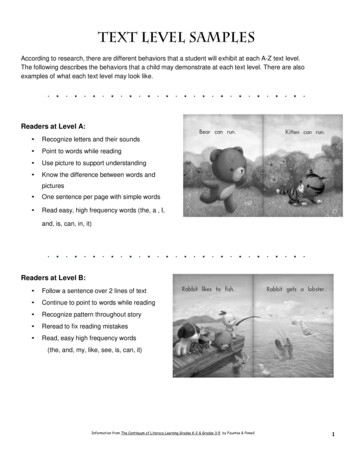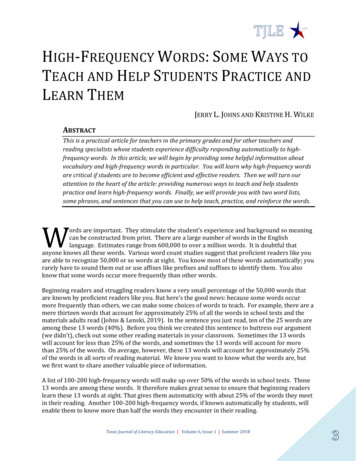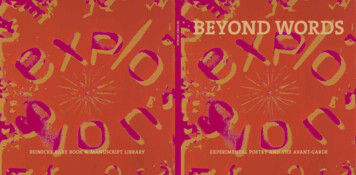
Transcription
BEYOND WORDSBEINECKE RARE BOOK & MANUSCRIPT LIBRARYBEYOND WORDSEXPERIMENTAL POETRY AND THE AVANT-GARDE
BEYOND WORDS
BEYOND WORDSEXPERIMENTAL POETRY AND THE AVANT-GARDE
BEYOND WORDSWords are at the heart and soul of poetry. Whether summoned in hours of deep contemplation, snatched from momentary flashes of inspiration, or allowed to tumble out freelyin the absence of conscious intervention, words combine togive a poem shape and substance: in the mind, the voice, onthe page. From traditional lines of alexandrine verse to thelatest experimental forms, they remain the essential element,carriers of sense, sound, cadence, meaning. So what is poetrybeyond words?The works in this exhibition challenge us to ask that question. How? Not necessarily by leaving words behind, thoughsome of them certainly do this too. Lettrist hypergraphies blastthe written word to bits. Not even vowels and consonantsare safe in Gil Wolman’s mégapneumes, or the cri-rythmes ofFrançois Dufrêne, or the recording sessions of Henri Chopin.But in most cases words abound, giving shape and substanceto nearly all the compositions of experimental poetry hereon display. Just as words have always done in poetry? Notquite. Even when they seem to make up the entire poem,words are by no means the only (or often even the primary)compositional element. Typography, layout, color (of ink orpaint), even the material supports on which these words appear (paper, canvas, wood, iron, magnetic tape, to name a few)all come into play. But don’t such elements belong to words?Aren’t they simply part of them, an incidental part at that, subordinate but necessary for words to take concrete physicalform and hence be read or heard? Well, no.Typography, layout,ink, material supports may be necessary for words to appearSo I judge a poem’s importance, if it is obviously as well conceived as possible, if it is also the most perfect, but above all ifit was capable of joining together man and poet, of becoming flesh and blood, movement and gesture, word and speech, if itknew beauty and started to sing, knew all the possibilities andcontained them all (all that which in the end we call spirit) inorder to be and remain, departed from out of chaos, the lastwriting. Only then is it a poem Henri Chopin, 1960on a page, but they can also be deployed for other purposes, even at cross purposes, striking out at words, challengingtheir sense, altering or entirely subverting their meaning. Bytaking them up as compositional elements in their own right,experimental poets and artists of the avant-garde ask us toexplore possibilities for creative expression in the purely visual, aural, tactile qualities of physical media. They ask us tolook beyond words.The range and diversity of experimental poetry is breathtaking. For more than a century now, the drive to uncoverexpressive potential in the nonverbal, physical side of the poetic medium has swept across continents and oceans, fromEurope to America, Brazil to Japan, giving rise to new movements, forms, and genres along the way. Much as Cubists andPost-Impressionists set the stage for a revolution in modern art by exploring the flatness of the canvas and the physical qualities of paint, experiments with the raw material ofprinting, handwriting, and (later) voice and sound recordingopened the door to a new understanding of poetry by altering perceptions of the nature and properties of languageand its media. In fact, the two revolutions were deeply intertwined. Collage, montage, juxtaposition, superimposition, theinclusion of sculptural and performative aspects, found material, film, video, and sound, the predilection for mixed mediain general are all common to contemporary art and experimental poetry today. So much so that the line between them,blurry from the start, seems increasingly difficult to draw. Inboth cases, ripples sent out by explosions at the turn of the5
BEYOND WORDStwentieth century continue to widen. There’s no telling whenor where they will end.Beyond Words explores just a small part of this vast universe. Giving little more than a brief nod to the revolutionarywork and significance of the historical avant-garde, the exhibition focuses almost exclusively on postwar ContinentalEurope. Even here, vital contributions from Eastern Europeare largely absent, despite the intimate ties that linked experimental poets on both sides of the Iron Curtain. Connections to British, American, and Japanese allies are likewise lost.Most conspicuous of all, the Brazilian concrete poets makeonly a cameo appearance, and primarily in the role of foils,their massive and global impact on experimental poetry andthe postwar avant-garde notwithstanding. Such omissions areglaring. Without collaboration of like-minded artists aroundthe world, the creative expanse of visual and sound poetrywithin postwar Europe itself is hardly imaginable. A glanceat exhibition programs or the pages of avant-garde reviewssuch as Cinquième Saison, Ou, De Tafelronde, and Lotta Poeticasuffices to see the importance Europeans placed on maintaining these global networks at the time. The choice to focus on works from the Continent – and on France, Belgium,and Italy in particular – obscures much that was essential totheir composition and meaning. But it also leaves room toexplore at least some intricacies of artists and movementsthat by and large still remain unfamiliar even to connoisseursof postwar experimental poetry. The works of Isidore Isou,Maurice Lemaître, Gil Wolman, and François Dufrêne provide6opportunity to consider the defining role of Lettrism and itsvarious offshoots, relegated to the margins of many existingnarratives, in shaping battles over visual and sound poetry inthe 1950s and ‘60s. The crucial alliances of Paul de Vree, firstwith Henri Chopin and later with Sarenco, emerge from theshadows to reveal the centrality of Belgium in the ‘60s and‘70s. Alongside Sarenco, Lamberto Pignotti, Luciano Caruso,and Ugo Carrega offer a glimpse into the complex, obscure,yet densely populated universe that is Italian poesia visiva. Although a small episode in a much larger story, the span of visual and sound poetry in postwar Europe easily stretches thebounds of a single exhibition.Bristling with color and texture, sight, sound, and passionate fury, experimental poetry reached a particular, heightenedintensity in the decades immediately following the SecondWorld War. Technological change played a part in driving thisamplification. The widespread availability of microphones andreel-to-reel tape recorders allowed sound poets to exploredimensions of the voice that had never been heard before,teasing out physical properties of breath and utterance beneath the articulation of words in order to manipulate, splice,overlay, compose with them. If the standard typewriter remained a favorite of visual poets, new processes of silkscreen,offset, and stencil printing, and above all the so-called “MimeoRevolution” in photoduplication vastly extended the repertoire and reach of their experiments. But technology onlygoes so far. Behind the impassioned deployment of these newmedia lay a desire to challenge the unthinking use of wordsas reliable purveyors of truth, especially when they fell intothe hands of a monstrous regime. The unspeakable trauma ofthe Second World War resounds in early Lettrist poetry, inthe “transhuman” compositions of Altagor, and most persistently through the oeuvre of Henri Chopin, who first learnedto savor the raw sounds of the human voice on an infamous“death march” from Nazi concentration camps, surroundedby fellow survivors from Eastern Europe speaking in tongueshe could not understand.“After the war we witness the deathof language as it was known,” Chopin wrote of the birth ofpostwar sound poetry: “the Word-Accomplice-of-the-OldWorld was besieged and broken.” Assaults on the “languageof power” only grew more urgent and strident in the worksof younger poets like Jean-François Bory. Dismayed by ColdWar propaganda, the increasingly sophisticated manipulationof text and image by mass media, the mindless conformityand new wars they seemed to dictate, experimental poetstook their anger into the streets. Spelled out in letters thesize of human bodies, wrapped in surgical bandages and splattered with red paint, the word ‘VIETNAM’ said it all in AlainArias-Misson’s first “public poem,” displayed for the benefit ofChristmas shoppers on a busy Brussels square. “Poesia visivais ‘a Trojan horse,’” Eugenio Miccini declared, explaining thestrategy of inverting the “iconography of mass media” in collaged poems: “and it wages war like a guerilla.”The experimental poetry of postwar Europe not onlyasks, but demands we take a closer look at words, pry intothem, beneath them, behind, above, and around them, in or-der to see what they are made of. Only then can we beginto grasp their meaning and explore possibilities that (also) liebeyond them. Drawn from rich archival holdings at BeineckeLibrary, the works on display tell only part of the story. As wecontinue to grapple with text, image, and sound in anotherage of new media and technological revolutions, it seems wellworth delving deeper into this past, much as the postwaravant-garde looked to Futurism, Dada, and Constructivism inconfronting the challenges of their own day. Beyond Words isan open invitation. Time to start digging in.7
IN PRINCIPIO ERAT
IN PRINCIPIO ERATIn the Beginning was the Word, so it is written, but the drive topush beyond it, to seek beauty and truth in abstract configurations, permutations, incantations of unfamiliar sounds seems tobe almost as old as writing itself. Dating from the fourth centuryB. C. E., Greek technopaignia, or “games of skill,” are among theearliest survivals of written poetry that drew significance notonly from words, but also from their physical arrangement inpatterns and talismanic forms. As prayers and magical incanta-Words lead back to their origin, which is the twenty-six lettersof the alphabet, so gifted with infinity that they finally consecrate Language.Stéphane Mallarmé, 1897tions, they likely point back to earlier traditions and were in turnpassed on by medieval scribes who painfully copied them (andno doubt added embellishments of their own) over a millennium later. Beautifully inscribed in red and black inks, the concentric circles and elaborate arrangement of text in and arounda tilted square in this thirteenth-century manuscript evince afascination for ancient forms of ars notoria, the direct invocation of esoteric knowledge, avidly pursued by scholars at latemedieval universities and renaissance acadApollonius (Tyanensis?), Ars Notoria, Sive Flores Aurei (France, or Northern Italy, c. 1225).emies. The “words” themselves consist largely of strange-sounding names of deities, transcribed into Latin from Arabic translations ofthe original Greek text, commonly ascribed tothe first-century Neopythagorean philosopher,magician, and master in the art of making talismans, Apollonius of Tyana. Inspired by examples from antiquity, poets of the Renaissanceand Baroque took great delight in composingwith shapes and letters, producing a stunningarray of labyrinths, mazes, acrostics, mesostics,lipograms, telestics, palindromes, rebuses, proteus poems, and other styles that were all therage across Europe in the sixteenth and seventeenth centuries. The sober tastes of neoclassicism and Enlightenment reason eventually spelled the end of this extravagant poesiaartificiosa, but not before the Cistercian monkJuan Caramuel de Lobkowitz compiled its se10crets in his magisterial Primus calamus ob oculus ponens metametricam of 1663.Pursued with such giddy abandon by Renaissance and Baroque poets (as Enlightenment critics sourly proclaimed), experiments with the visual, non-verbal aspects of writing fell outof favor in the Age of Reason and did not resume in earnestuntil the turn of the twentieth century. The renewed fascination with shapes, sizes, configurations of words and letters onthe printed page seemed to spring up fully formed, almost outof nowhere. First published in the literary review Cosmopolis in1897, Stéphane Mallarmé’s A Roll of the Dice Will Never AbolishChance stands alone at the dawn of modern visual poetry, brilliant, haunting, serene, revolutionary, a monument to the Symbolist conjuring of Language unrivaled in its impact on avantgarde experiments with typography and layout for generationsto come. “The ‘blanks’ in fact assume importance, strike first,versification demanded it, as silence all around,” Mallarmé explained. With only “a third of the leaf ” left for words, font size,placement, and the sheer presence of the material supportplayed a central role in achieving poetic effect across tumblinglines of fragmented verse. “The paper intervenes each time asimage, of itself, ends or resumes, accepting the succession of theothers.” The effect of this “distance copiée, which mentally separates groups of words or words among themselves,” was to “accelerate and sometimes to slow the movement, the scansion,the intimation even, in accordance with a simultaneous vision ofthe Page: this latter taken as a unit, as Verse or the perfect lineis elsewhere.” Unsatisfied with initial results, Mallarmé workedJuan Caramuel Lobkowitz, Primvs calamvs ob ocvlos ponens metametricam(Rome, 1663).11
IN PRINCIPIO ERAT Stéphane Mallarmé, Un coup de désjamais n’abolira le hazard: poème(Paris, 1914).Marcel Broodthaers, Un coup de désjamais n’abolira le hazard: image(Antwerp, 1969).Belgian experimental poet MarcelBroodthaers conveys the profoundand lasting impact of Mallarmé’sCoup de dés, translating it from“poem” into pure abstract “image”in this striking reimagining of 1969.Words disappear entirely in anotherwise painstaking recreation ofthe Gallimard edition, leaving onlyvisual registers of size, shape, andplacement in geometric blocks ofcanceled text. Translucent paper allows not just a single spread, but theentire succession of layouts to shimmer forth in a vision Mallarmé himself could scarcely have imagined. Afitting tribute, in Broodthaers’s eyes,to the Symbolist poet he believedhad “unwittingly invented modernspace.”12out meticulous instructions for layouts of a large paper editionbut died before the project could be realized. It would take another seventeen years for the poet’s “simultaneous vision” toachieve full measure on the magnificent two-page spreads ofthe 1914 Gallimard edition.In the beginning was Mallarmé. But new experiments withtypography and layout were quick to follow, pushing visual poetry in ever more adventurous and radical directions. Stunned bythe dynamic fracturing of the pictorial plane in Cubist paintings,avant-garde poet Guillaume Apollinaire strew constellations oflanguage clusters across the page to construct his calligrammes,an early attempt at non-linear writing and simultaneity that likewise drew inspiration from the brash concoctions of text andimage in modern advertising: “You read the handbills catalogsposters singing at the top of their lungs /There’s this morning’spoetry for you, and for prose there are the newspapers.” Suchflights of fancy took Apollinaire far from the serene world ofMallarmé, who condemned newspapers as an “improper use ofprinting” good only for use as “packing paper.” But the Italian Futurists went even further. Demanding the “destruction of syntax,”F. T. Marinetti launched a “typographic revolution” aimed at freeing words from the straightjacket of sense-making and poeticconvention altogether. While Apollinaire’s calligrammes conceala prescribed sequence and order, Futurist “Words-in-Freedom”defy any single approach, challenging the reader to find hisor her own way through a “chaos” of verbal and visual signsheld together only by onomatopoeia and intuitive “analogies”formed from the adjacencies of discordant elements. “ I opposeParole, consonanti, vocali, numeri in libertà (Milan, 1915).Not just words, but “CONSONANTS VOWELS NUMBERS IN FREEDOM,” the banner of this Futurist manifesto proclaims. With its profusion of mathematical symbols, fractured and distorted words, letters repeated instrings or standing alone like mountain peaks, Marinetti’s1915 “Montagnes vallées routes Joffré” takes adecisive step onto the (battle)field of avant-garde poetrybeyond words.13
IN PRINCIPIO ERATthe decorative, precious aesthetic of Mallarmé and his searchfor the rare word, the one indispensable, elegant, suggestive, exquisite adjective,” Marinetti fumed. “Moreover, I combatMallarmé’s static ideal with this typographic revolution, whichallows me to impress on words (already free, dynamic, andtorpedo-like) every velocity of the stars, the clouds, airplanes,trains, waves, explosives, globules of seafoam, molecules, andatoms.”There was no turning back. Once unleashed, the creativefury of avant-garde experimentation raged swiftly across Europe, tearing conventional understandings of poetry apart inexplosion after explosion of radical innovation. By the timeMarinetti visited Saint Petersburg in January 1914, he was greeted with jeers from “Cubo-Futurist” poets, who insisted Russian experiments with zaum, or “beyondsense” language, hadalready surpassed anything “Words-in-Freedom” had to offer.“We alone are the face of our Time.Through us the horn of timeblows in the art of the world,” declared David Burliuk, Aleksei Kruchenykh, Vladimir Mayakovsky, and Velimir Khlebnikov intheir 1912 manifesto – defiantly wrapped in burlap – A Slap inthe Face of Public Taste. With the outbreak of the First WorldWar, assaults on conventional language assumed a new urgency,especially for the poets who launched Dada on stage at theCabaret Voltaire in Zurich in 1916. Driven on by the gruesome“sense” of jingoistic nationalism and the carnage it was producing, Hugo Ball’s absurdist sound poetry, Tristan Tzara’s mad callsfor the right “to piss in different colors,” and other outrageousacts of Dada performance expressed a contempt for the power14of the word experimental poets would feel all the more keenlyafter the atrocities of the Second World War. “This age has notsucceeded in winning our respect. What could be respectableand impressive about it?” Ball demanded in 1916, as the battlesof Verdun and the Somme ground on. “Its cannons? Our bigdrum drowns them out. Its idealism? That has long been a laughing stock, in its popular and its academic edition. The grandioseslaughters and cannibalistic exploits? Our spontaneous foolishness and enthusiasm for illusion will destroy them.”Experiments with visual and sound poetry continued toevolve in the 1920s and ‘30s, unfolding in a landscape far toovast to explore here. As Mayakovsky, Kruchenykh, and otherschanneled the explosive wave of Russian Futurism into the earlySoviet avant-garde, forging alliances with Constructivist artistsand designers like El Lissitzky, zaum also traveled west with theGeorgian poet and master print-maker Iliazd, who joined in thecreative fervent of Dada and Surrealism in Paris after fleeingTblisi in the wake of the Bolshevik Revolution. Ripples, crosscurrents, and swirling convergences fed a torrent of new experimental poetry, filling the pages of avant-garde journals withmasterpieces of high modernist innovation, many of which laterfound a place in Iliazd’s epoch-making 1949 compendium, Poetry of Unknown Words. Doubtless one of the most beautiful artistbooks of the twentieth century, Poésie de mots inconnus pairsoriginal works by Picasso, Braque, Chagall, Matisse, Léger, Miró,Giacometti, and others alongside the “unknown words” of Balland Tzara, Khlebnikov and Kruchenykh, Michel Seuphor, PierreAlbert-Birot, Camille Bryen, Raoul Hausmann, Kurt Schwitters– in all twenty-two visual and sound poets, including of courseIliazd himself. Set out with typographic genius on page after exquisitely crafted page, the work is a masterpiece in its own right,an irrefutable testament to the creative achievements of whatis now called the “historical avant-garde.”But it was only another beginning. Before moving on to theradical departures of the postwar avant-garde, it is well worthpausing to dwell over one last landmark of the modernist era:the Ursonate of Kurt Schwitters. As Mallarmé’s Coup de déstowers at the dawn of modern visual poetry,the Ursonate has assumed nearly mythical status in origin stories of contemporary soundpoetry. Emerging from over a decade of experiment, recital, and refinement, the poemlives and breathes the spirit of creative intermingling of the 1920s, drawing as deeply onits crosscurrents as any work of the age. The“poster poems” of Raoul Hausmann, a centralfigure in Berlin Dada, gave Schwitters the initial nudge, but Russian Futurism and zaum alsoplayed a hand, as did the artist’s close collaboration with the Constructivist El Lissitzky inthe crucial years of the poem’s composition.And it is surely no accident that Schwitterssent a personally inscribed copy to the founder of Italian Futurism, F. T. Marinetti. Composedalmost entirely of pure vocal acoustics, or “primal sounds,” the Ursonate relies on typogra-phy and layout to indicate timbre, cadence, and melody – likeMallarmé, Schwitters viewed the results of his experiment asa musical score – while strings of letters denoted the soundsthemselves. “Not words, but letters are originally the materialof poetry, Schwitters wrote, explaining the concept of “consistent poetry” behind the Ursonate in 1924. “Letters do not haveideas. Letters have no sound, they only give possibilities to beinterpreted into sound by the one who performs.”Kurt Schwitters, Ursonate (Hannover, 1932).15
LETTRIST DETONATIONS
LETTRIST DETONATIONSLettrism, the first avant-garde movement of the postwar era, arrived in Paris in the suitcase of a young Rumanian exile, IsidoreIsou, who had picked his way across war-torn Europe to throwa bomb in the lap of the literary establishment in 1945. “It is nota matter of: destroying words for more words, nor of: forgingnotions to clarify their nuances, nor of: mixing terms to makethem hold more meanings,” Isou insisted, but of “unfolding beforedazzled spectators marvels realized in letters (debris of destructions).” Conceived in the darkest hours of the Nazi conquest ofEurope, Lettrism spoke the language of war, occupation, trauma,holocaust. “The Word Assassinates sensibilities. Indifferentlyuniforms torturing inspiration. Twists tensions,” one reads in thefirst manifesto of Lettrism, dated 1942: “The word is the firststereotype.” Once in Paris, Isou set out to “vanquish the City,”joining forces with the young vagabond poet Gabriel Pomerand to put Lettrism on stage in the jazz cellars of Saint-Germain-des-Prés, while at the same time lobbying Jean Paulhan,the influential editor of the Nouvelle Revue française, to publishhis Introduction to a New Poetry and a New Music with Gallimard. Proclaiming himself leader of the first movement to unleash the explosive force of pure sound and naked letters, Isoufocused his attack not only on conventional poetry, but also –and most vehemently – on the poets of Dada and Surrealism,whom he accused of having betrayed the historic mission of theavant-garde by stopping their assault on language at the level ofwords. “Dada is dead!” Isou declared, disrupting a lecture by Michel Leiris at the premier of Tzara’s latest play, The Fight, in 1946.“We know all that, enough of all that old stuff!” his rowdy band18To vanquish, Lettrism must be PURIFICATION, VENGEANCE,TERROR.Soon the first fires will engulf the bordels of Paris to makemore room for Lettrism.I promise you this!MY LIFE must be a great ACTION.Gabriel Pomerand, 1946GUERINGUE! himler, guimière, mèringuejimière, jèringue.HASS!lebanne – letrain; le train lebannele vanne – leganne – lemains ff-iB ßßAuschwitz – schwitz – schwitzAuschwitz – schwitz – schwitzBuchenwald!Bouhnwald!ADONOOOI! ADONOI!Belsen – BergenBELSEN – algal – RaïwensguergueRanne – Wilde WaïbensguergueWOI zennenne FANNY moïsché rachelleOI! CHHEMA ISRAELLE!élohénou lad!élohénouEHAD!M9µExcerpt from Isidore Isou, “Cris pour 5.000.000 juifs égorgés,” 1947.of acolytes chimed in. “We want to hear about something new, ing early compilations in hislet’s hear about Lettrism!” When Iliazd held a conference to new review Ur, as did Jeandispute Isou’s claims a few months later, a Lettrist “militant” at- Louis Brau, Serge Berna, Giltacked one of the speakers, wounding him with a chair. The in- Wolman, and other rebelliousjured party was none other than Camille Bryen, duly honored youth, who quickly found awith a page in Iliazd’s ultimate rebuttal, Poésie de mots inconnus, voice all their own. “Isou waswhich was also a call to arms: “This book was made by Iliazd to an end. In the beginning wasillustrate the cause of his companions.” The battles over experi- Wolman,” the latter wrote inthe first issue of Ur, pokingmental poetry in postwar Europe had begun.Screamed, shouted, whispered, hissed, Lettrist sound poetry fun at the exaggerated claimsthrived in the intoxicating climate of jazz clubs like the Tabou, of Lettrism’s founder. Experwhere Pomerand hurled staccato lines at crowds of dazed rev- imenting with microphoneselers, standing on a table in their midst: “Ta ra ta ta koum bal in live performance, Wolkoum bal kim piki ta ra ta ta ” If Isou shocked Parisians man had in fact pushed further, tearing Au Tabou: 4 Recitals Lettristes (Paris,with somber poems com1950).letters apartposed from names of in- Isidore Isou, “Jungle,” in Introduction à une nouvelle Poèsieet à une nouvelle musique (Paris, 1947).to reveal qualities of the voice and sounds offamous war criminals andthe human body concealed inside. “From evdeath camps – and the “cries”ery letter there emanates a mass of vibraof “butchered Jews” – he alsotions that remain inaudible.” Detached fromswayed to the rhythm andconsonants and given structure as an “en soi”beat of jazz in more “joyousindependent of vowels, breath was the medipoems” like “Swing” and “Junum of Wolman’s mégapneumie, a new form ofgle.” Others soon joined in.wrenching, guttural sound poetry that seemedJust sixteen years old, Franto point beyond Lettrism from the start.çois Dufrêne began composing Lettrist poems in 1947.“Isou did not destroy the word for the letter but the concept, which naturally led himThree years later, Maurice Leto take back the letter and create words,”maître joined the fold, publish19
LETTRIST DETONATIONS Maurice Lemaître, Bilan lettriste(Paris, 1955).Lettrist experiments with the soundsof the body quickly ran up againstthe limits of the alphabet as a toolfor scripting a poetry beyond words(Kurt Schwitters had already madethe same discovery when composing the Ursonate). Published inMaurice Lemaître’s 1952 System ofNotation for Lettries, a phonetic chartlays the groundwork for a wholescheme of complementary signsand symbols, arranging elementsof vocal acoustics according to theanatomical part responsible for theirproduction – lips, palate and tongue,nose, larynx, lungs (and whethereither inhalation or exhalation wasinvolved).Wolman mused, working out the implications of his own discovery in an early fragment. “Mégapneumie takes possession ofeach of the signs of letters and commences the notation of allhuman sounds.”Lettrism, however, was about more than just sound. Whilethe wild nights of improvisation at the Tabou and other venuesdrove some to explore pure bodily acoustics devoid of visualsigns – Dufrêne abandoned writing (and Lettrism) altogetherto pursue his cri-rythmes through live performance and soundrecording – Isou, Pomerand, and Lemaître quickly turned topainting, sculpture, photography, and cinema as means to prynew creative potential out of the graphic, or “ocular,” dimensions of their medium. Pouring letters, signs, and symbols over20the surfaces of canvas, walls, photographs, even raw film footage, sculpting them into material objects, the Lettrists strove tocreate an entirely new form of art from the seemingly endlesspotential they had discovered here. “Starting with painting, Isoulooks toward the transformation of the art of the tableau andopens the path of discovery as far as the coincidence of theplastic object with the orthographic element,” the founder of Lettrism enthused: “Any form at all can become a letter. An enormous universe of writing, in which things mutate into personalsigns, unveils itself to the lovers of construction.” Still, soundcontinued to play a role in early Lettrist experiments with thevisual and tactile properties of “letter / objects.” Coinciding withattempts to invent a system of notation for sound poetry, Lettrist painting and sculpture seemed in many ways to grow outof them, extending their reach to include rebuses, “hieroglyphs,”and other visual elementsthat served as phonetic signs. Maurice Lemaître, photo lettriste, inThe initial result, as Wolman Ur no. 3 (1953).rightly noted, was a return to“the word” very much at oddswith the original explosiveforce of Lettrist detonations.Eye-catching works such asIsou’s Journals of the Gods, oneof three “metagraphic novels”published in 1950, shatteredthe conventions of writingonly to replace them with afresh profusion of “personal signs” that, once sounded out in aslow (and as many found, tedious) process of decipherment, ledstraight back to the established syntax, grammar, and vocabularyof ordinary French. It was only with Lemaître’s inauguration ofhypergraphies at the Galerie Prismes in 1955 that Lettrism leftsound puzzles and rebuses behind to explore the pure visuality of signs.True to its combative origins, Lettrism sparked rife contention and battles that quickly fractured the movement into rivalfactions in the early 1950s. While Dufrêne left with others tolaunch Le Soulèvement de la Jeunesse, or “Uprising of Youth,”Wolman, Be
their composition and meaning. But it also leaves room to explore at least some intricacies of artists and movements that by and large still remain unfamiliar even to connoisseurs of postwar experimental poetry. The works of Isidore Isou, Maurice Lemaître, Gil Wolman, and François Dufrêne provide BEYOND WORDS

